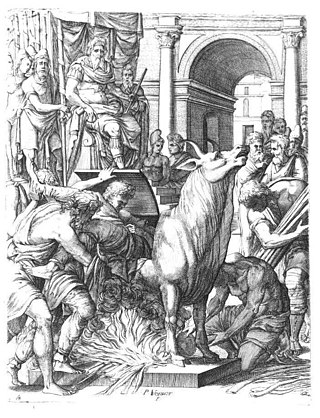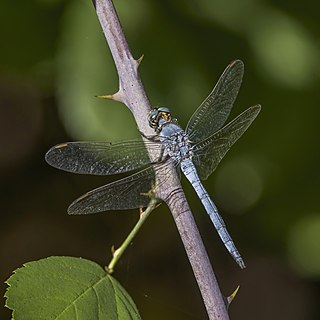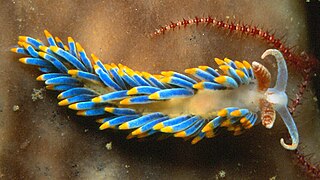
Arundo is a genus of stout, perennial plants in the grass family.

Phalaris was the tyrant of Akragas in Sicily in Magna Graecia, from approximately 570 to 554 BC.

Phalaris arundinacea, or reed canary grass, is a tall, perennial bunchgrass that commonly forms extensive single-species stands along the margins of lakes and streams and in wet open areas, with a wide distribution in Europe, Asia, northern Africa and North America. Other common names for the plant include gardener's-garters and ribbon grass in English, alpiste roseau in French, Rohrglanzgras in German, kusa-yoshi in Japanese, caniço-malhado in Portuguese, and hierba cinta and pasto cinto in Spanish.

Phalaris is a genus of flowering plants in the grass family. Species of Phalaris are distributed across all continents except Antarctica. They can be found in a broad range of habitats from below sea level to thousands of feet above sea level and from wet marshy areas to dry places. P. arundinacea and P. aquatica are sometimes invasive species in wetlands.

The keeled skimmer is a species of dragonfly belonging to the family Libellulidae.

Canary grass is a plant, Phalaris canariensis, belonging to the family Poaceae. Originally a native of the Mediterranean region, it is now grown commercially in several parts of the world for birdseed.

Phalaris aquatica, known by the common names bulbous canary-grass and Harding grass, is a species of grass in the genus Phalaris of the family Poaceae.

The cerulean kingfisher is a kingfisher in the subfamily Alcedininae which is native to parts of Indonesia. With an overall metallic blue impression, it is very similar to the common kingfisher, but it is white underneath instead of orange. Males average bluer than females, which have a greenish cast.

The pearly parakeet, known as the pearly conure in aviculture, is a Vulnerable species in subfamily Arinae of the family Psittacidae, the African and New World parrots. It is endemic to Brazil.
Antona is a genus of moths in the subfamily Arctiinae. The genus was erected by Francis Walker in 1854.

The Florida scrub jay is one of the species of scrub jay native to North America. It is the only species of bird endemic to the U.S. state of Florida and one of only 15 species endemic to the continental United States. Because of this, it is keenly sought by birders. It is known to have been present in Florida as a distinct species for at least 2 million years, and is possibly derived from the ancestors of Woodhouse's scrub jay.

Phalaris minor is a species of grass native to North Africa, Europe, and South Asia. The bunchgrass is widely naturalised elsewhere.

The brazen bull, also known as the bronze bull, Sicilian bull, or bull of Phalaris, was a torture and execution device designed in ancient Greece. According to Diodorus Siculus, recounting the story in Bibliotheca historica, Perilaus (Περίλαος) of Athens invented and proposed it to Phalaris, the tyrant of Akragas, Sicily, as a new means of execution. The bull was said to have been hollow, and made entirely of bronze, with a door in one side. Allegedly, the condemned were locked inside the device, and a fire was set beneath it, heating the metal to the extent that the person within slowly roasted to death. The bull was equipped with an internal acoustic apparatus that converted the screams of the dying into what sounded like the bellows of a bull. The bull's design was such that steam from the cooking flesh of the condemned exited the bull's nostrils; this effect—along with the bull's "bellows"—created the illusion that the bull came to life during every execution. Pindar, who lived less than a century later, expressly associates this instrument of torture with the name of the tyrant Phalaris.

Vanda coerulescens, also known as sky-blue vanda, is a species of monopodial orchid native to Assam and Arunachal Pradesh, India, eastern Himalayas, southern Yunnan province in China, Myanmar and Thailand.

Ambulyx is a genus of moths in the family Sphingidae, described by Westwood in 1847.

Berghia coerulescens is a species of sea slug, a marine nudibranch in the family Aeolidiidae. It is the type species of the genus Berghia.

Phalaris was a British bred Thoroughbred racehorse, later a Leading sire in Great Britain and Ireland and a Leading broodmare sire in Great Britain & Ireland. He appears in the sireline of all racehorses which were winners of more than $10 million, as well as all yearlings that were auctioned for more than $7.5 million.
Parachaetolopha is a genus of moths in the family Geometridae. Most species were previously included in the genus Chaetolopha.
Parachaetolopha coerulescens is a moth in the family Geometridae. It is found in Papua New Guinea.

Coerulescine is an oxindole alkaloid found in the plant Phalaris coerulescens.















